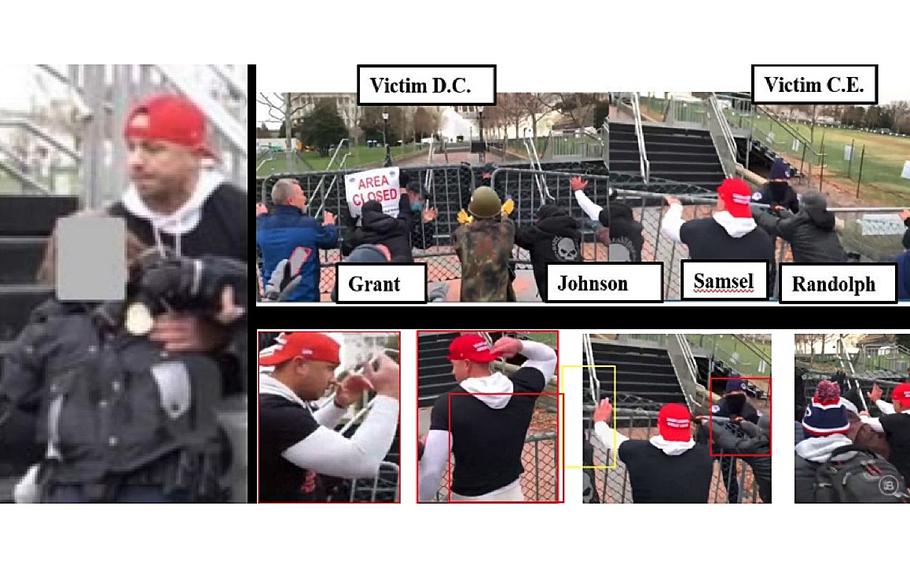
(FBI court filing)
They were five men from five different states who’d never met each other. But on Jan. 6, 2021, they found themselves together at the front of the angry push by rioters toward the U.S. Capitol. And together, video showed, they lifted a line of five linked barriers and heaved them into a group of five Capitol Police officers with such force that one of the officers went airborne, striking her head and falling briefly unconscious.
The encounter at the Peace Circle, prosecutors said, cleared the first path for rioters to reach the Capitol where Trump supporters on the west side of the building surged forward as the police retreated. The five men continued to wreak havoc, fighting with officers or encouraging other rioters to push ahead, and on Friday a federal judge found all five guilty of assaulting law enforcement and convicted three of them for obstructing the confirmation of the 2020 presidential election.
“These are the defendants who started it,” Assistant U.S. Attorney Alexandra F. Foster said in her closing argument Nov. 2 to U.S. District Judge Jia M. Cobb, after the defendants chose a bench trial instead of a jury trial. “There is little doubt that this moment ignited a fire that lasted around the Capitol for hours … They started the Capitol breach. Now they must take responsibility.”
Defense lawyers argued that pinning responsibility on five men for a riot involving thousands of others was unfair. Ryan Samsel, 39, of Bristol, Pa., was the most prominent of the group, first unlatching the barricades at an unguarded spot on the Peace Circle, then leading the crowd toward a second line where he yelled at police and was part of the effort to launch the bike racks at the five officers, video played at trial showed. He has been in jail since January 2021, in part because of multiple violent assault convictions in previous years, mostly against women, and a pending arrest warrant for violating a restraining order.
Samsel attorney Stanley Woodward said that the five men didn’t launch the insurrection. “I think history, and only history, will tell us who started the riot on Jan. 6,” Woodward said. “But we can’t, in good faith, submit that one person, or even five people, are culpable for the events that day.” He noted that surveillance video showed that other rioters approached the Capitol from a different angle than those from the Peace Circle, but prosecutors maintained that the Peace Circle was the first breach of the restricted perimeter.

Marine veteran Ray Epps is seen talking with accused Jan. 6 rioter and Proud Boys member Ryan Samsel near the Peace Circle monument. (FBI court filing)
Samsel has gained notoriety because immediately before the assault began, he was caught on video speaking briefly with two other prominent figures from that day: Joseph Biggs and Ray Epps. Biggs, one of the leaders of the Proud Boys, could be seen talking to Samsel, giving the impression that Samsel was part of the far-right group. Samsel later denied that, and Biggs was subsequently found guilty of seditious conspiracy and sentenced to 17 years in prison.
Epps has been the focus of claims that he was as an undercover federal agent, working to inflame the crowd. Epps and Samsel have both said that Epps was urging Samsel not to attack the police. Epps was sentenced to probation in January.
Samsel did not take the stand in his own defense. Nor did any of his co-defendants: James T. Grant, 31, of Cary, N.C.; Paul R. Johnson, 38, of Lanexa, Va.; Stephen C. Randolph, 34, of Harrodsburg, Ky.; or Jason B. Blythe, 28, of Fort Worth.
But Officer Caroline Edwards did take the stand. And, as she did when she provided riveting testimony in 2022 at the House select committee hearings on the Jan. 6 riot, she described watching the growing crowd move toward her small group of officers, and then trying to hold the line as the rioters began shaking the barricades and insulting the police.
Video shot from behind the rioters shows Edwards and the other officers trying to maintain control of the bike racks. But then a rack on the far right is lifted away from a stone wall, and the line of barriers moves quickly forward. Edwards said a steel rack first struck her in the jaw, then knocked her into a stairway railing and then to the ground.
“I landed with my head on the stairs,” Edwards testified, according to NBC News, though the last thing she remembered was being hit in the jaw. The video showed that Samsel then ran around the downed barricades and picked Edwards up, but she shook him off and headed toward the Capitol.

U.S. Capitol Police officer Caroline Edwards testifies in June 2022 during the House Select Committee hearings investigating the Jan. 6 attack on the U.S. Capitol. (Demetrius Freeman/The Washington Post)
“The lights were on, but no one was home,” Edwards said. Edwards suffered a concussion, then endured vertigo and migraine headaches for months when she could not get out of bed, prosecutors said.
As the crowd overran the police and headed for the West Terrace of the Capitol, video showed Samsel on Capitol grounds for another 90 minutes, trying to pull a riot shield away from police, trying to dismantle one of the inauguration scaffolds and throwing a long two-by-four plank at officers.
Johnson could be seen with a megaphone, both at the Peace Circle and then at the Capitol, profanely insulting police and repeatedly urging rioters to press forward. On the West Terrace, Johnson can be heard “telling the rioters where to go and what to do,” Foster said. After Vice President Mike Pence declined to stop the certification of the 2020 election, Johnson advised rioters to consult their phones for updates, and then yelled: “They certified the vote … They just stole it. You gonna stand around?”
Lauren Rosen, Johnson’s lawyer, argued that “this is a case where the government overcharged an individual who made a poor decision.” She said that “not everyone present at Peace Circle is responsible for the offense against Officer Edwards,” and that the bike racks were “not a deadly or dangerous weapon.”
Grant could be seen on video arguing with officers at the Peace Circle, then shoving up against another line of officers on the West Terrace before entering the Capitol, where he posed for pictures inside a Senate office. Randolph was visited by an undercover agent who recorded Randolph admitting being at the Capitol but not going inside, an audio recording showed. Foster said Blythe “came ready for battle,” wearing a helmet and body armor.
Lawyers for Grant, Randolph and Blythe told the judge that the defendants didn’t know one another, didn’t act together and didn’t deserve felony charges with 20-year maximum sentences. “These are five misbegotten, woebegotten people,” Grant’s attorney Robert Feitel said, “who had the misfortune to be in the same place at the same time.”
All five defendants were convicted of felony civil disorder and one count of assaulting a police officer in addition to multiple trespassing-related misdemeanors. Samsel, Grant and Johnson were convicted of obstructing an official proceeding, but Cobb acquitted Blythe and Randolph of those counts. The judge did not announce her reasons for the verdicts and said she would post a written order later.
Samsel and Grant are already in jail, and prosecutors asked Cobb after the verdicts to order the other three defendants into custody. Judges in the D.C. federal court have largely declined to imprison defendants after guilty verdicts, and Cobb also declined to send the three men to jail. But she did ask for a briefing on the issue from both sides and left open the possibility that Johnson, Blythe and Randolph may have to surrender before sentencing, which she set for June 13.